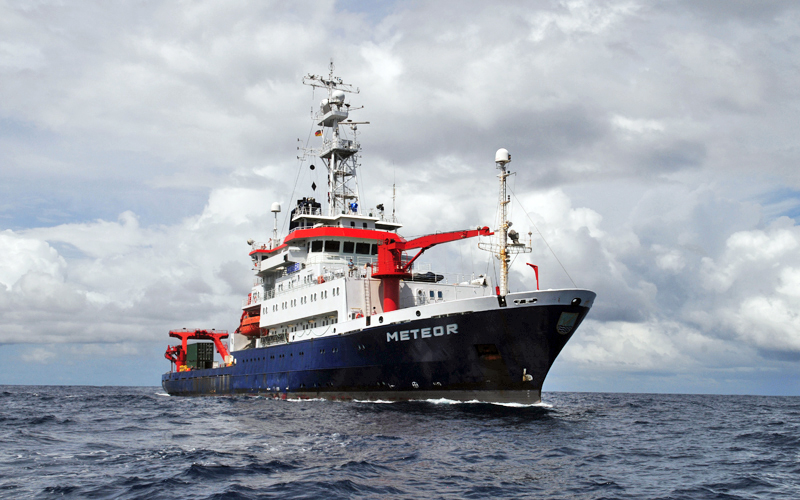METEOR M116/1
- Area:
- Tropical Atlantic
- Time:
-
01.05.2015 - 03.06.2015
- Institution:
- GEOMAR
- Chief scientist:
- Martin Visbeck
Oxygen minimum zones (OMZ) in the depth range 100 to 900 m cover the eastern tropical regions of the Atlantic and Pacific oceans. The lowest oxygen values in the At-lantic are encountered at 300 to 500 m depth with a sharp increase towards the surface layers. The OMZ of the Eastern Tropical North Atlantic (ETNA) has mini-mum oxygen values of about 40 μmol/kg. The ventilation, i.e. transport processes that supply oxygen to the interior ocean, is not homogeneous and may occur via more than one pathway. In particular, the ventilation processes of the so-called ‘shadow zones’ which host the OMZs have not been fully established. In order to quantify the rates and efficiencies of each pathway, a combined approach using both models and ob-servations is used.
In the oxygen supply tracer release experiment (OSTRE), we focus on the horizontal oxygen supply route in the tropical North Atlantic Oxygen Minimum Zone (OMZ). An artificial tracer was released in the center of the OMZ (both in a lateral and vertical sense) in December 2012, during cruise MSM23. Since then its distribution has been observed on several expeditions. OSTRE will directly address an emerging central issue of the SFB 754: How is dissolved oxygen transported into the OMZ across mean oxygen gradients? This cannot be the result of a mean flow, which in the absence of mixing and/or significant local sources and sinks must be aligned parallel to mean property gradients. Thus the oxygen supply to the OMZ must be facilitated by non-linear stirring, most likely due to eddy mixing processes. How efficient are they? And do our models give a quantitatively correct representation of this fundamental process of OMZ dynamics?
Goals of the cruise are to:
1) Quantify the oxygen distribution of tropi-cal North Atlantic OMZ with high temporal and spatial resolution
2) Identify subtropical-tropical circulation pathways that provide oxygen to the eastern tropical oxygen minimum zones
3) Observe temporal variability (e.g. inter-annual, seasonal, short-term) in the supply of oxygen to and in the inventory of oxygen in the OMZ.
In addition to the above we will conduct measurements of the carbonate system, nu-trients and transient tracers. This constitutes of repeat measurements of stations where high accuracy carbonate, oxygen and nutrient measurements has been done in the past with the goal of quantifying decadal scale changes in physics and biogeochemistry of the interior ocean.
Continuous surface water measurements of the following parameters will be conducted throughout the entire cruise: sea surface temperature (SST), salinity (SSS), and dissolved oxygen concentration.
We will also support the global observing network of profiling floats, Argo, by deploying ten of those floats during the cruise. These floats will make a profile down to 2000 meters about once a week for a time-period of up to 5 years and send the data back via satellite; this is the most important observing system for quantifying changes in ocean heat content.



